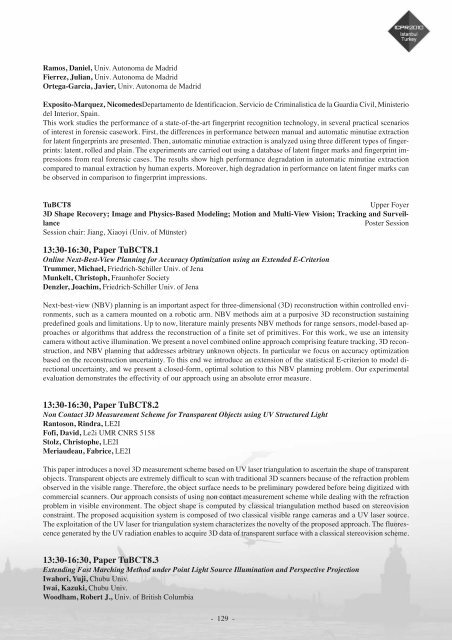Abstract book (pdf) - ICPR 2010
Abstract book (pdf) - ICPR 2010
Abstract book (pdf) - ICPR 2010
- TAGS
- abstract
- icpr
- icpr2010.org
Create successful ePaper yourself
Turn your PDF publications into a flip-book with our unique Google optimized e-Paper software.
Ramos, Daniel, Univ. Autonoma de Madrid<br />
Fierrez, Julian, Univ. Autonoma de Madrid<br />
Ortega-Garcia, Javier, Univ. Autonoma de Madrid<br />
Exposito-Marquez, NicomedesDepartamento de Identificacion. Servicio de Criminalistica de la Guardia Civil, Ministerio<br />
del Interior, Spain.<br />
This work studies the performance of a state-of-the-art fingerprint recognition technology, in several practical scenarios<br />
of interest in forensic casework. First, the differences in performance between manual and automatic minutiae extraction<br />
for latent fingerprints are presented. Then, automatic minutiae extraction is analyzed using three different types of fingerprints:<br />
latent, rolled and plain. The experiments are carried out using a database of latent finger marks and fingerprint impressions<br />
from real forensic cases. The results show high performance degradation in automatic minutiae extraction<br />
compared to manual extraction by human experts. Moreover, high degradation in performance on latent finger marks can<br />
be observed in comparison to fingerprint impressions.<br />
TuBCT8 Upper Foyer<br />
3D Shape Recovery; Image and Physics-Based Modeling; Motion and Multi-View Vision; Tracking and Surveillance<br />
Poster Session<br />
Session chair: Jiang, Xiaoyi (Univ. of Münster)<br />
13:30-16:30, Paper TuBCT8.1<br />
Online Next-Best-View Planning for Accuracy Optimization using an Extended E-Criterion<br />
Trummer, Michael, Friedrich-Schiller Univ. of Jena<br />
Munkelt, Christoph, Fraunhofer Society<br />
Denzler, Joachim, Friedrich-Schiller Univ. of Jena<br />
Next-best-view (NBV) planning is an important aspect for three-dimensional (3D) reconstruction within controlled environments,<br />
such as a camera mounted on a robotic arm. NBV methods aim at a purposive 3D reconstruction sustaining<br />
predefined goals and limitations. Up to now, literature mainly presents NBV methods for range sensors, model-based approaches<br />
or algorithms that address the reconstruction of a finite set of primitives. For this work, we use an intensity<br />
camera without active illumination. We present a novel combined online approach comprising feature tracking, 3D reconstruction,<br />
and NBV planning that addresses arbitrary unknown objects. In particular we focus on accuracy optimization<br />
based on the reconstruction uncertainty. To this end we introduce an extension of the statistical E-criterion to model directional<br />
uncertainty, and we present a closed-form, optimal solution to this NBV planning problem. Our experimental<br />
evaluation demonstrates the effectivity of our approach using an absolute error measure.<br />
13:30-16:30, Paper TuBCT8.2<br />
Non Contact 3D Measurement Scheme for Transparent Objects using UV Structured Light<br />
Rantoson, Rindra, LE2I<br />
Fofi, David, Le2i UMR CNRS 5158<br />
Stolz, Christophe, LE2I<br />
Meriaudeau, Fabrice, LE2I<br />
This paper introduces a novel 3D measurement scheme based on UV laser triangulation to ascertain the shape of transparent<br />
objects. Transparent objects are extremely difficult to scan with traditional 3D scanners because of the refraction problem<br />
observed in the visible range. Therefore, the object surface needs to be preliminary powdered before being digitized with<br />
commercial scanners. Our approach consists of using non contact measurement scheme while dealing with the refraction<br />
problem in visible environment. The object shape is computed by classical triangulation method based on stereovision<br />
constraint. The proposed acquisition system is composed of two classical visible range cameras and a UV laser source.<br />
The exploitation of the UV laser for triangulation system characterizes the novelty of the proposed approach. The fluorescence<br />
generated by the UV radiation enables to acquire 3D data of transparent surface with a classical stereovision scheme.<br />
13:30-16:30, Paper TuBCT8.3<br />
Extending Fast Marching Method under Point Light Source Illumination and Perspective Projection<br />
Iwahori, Yuji, Chubu Univ.<br />
Iwai, Kazuki, Chubu Univ.<br />
Woodham, Robert J., Univ. of British Columbia<br />
- 129 -



